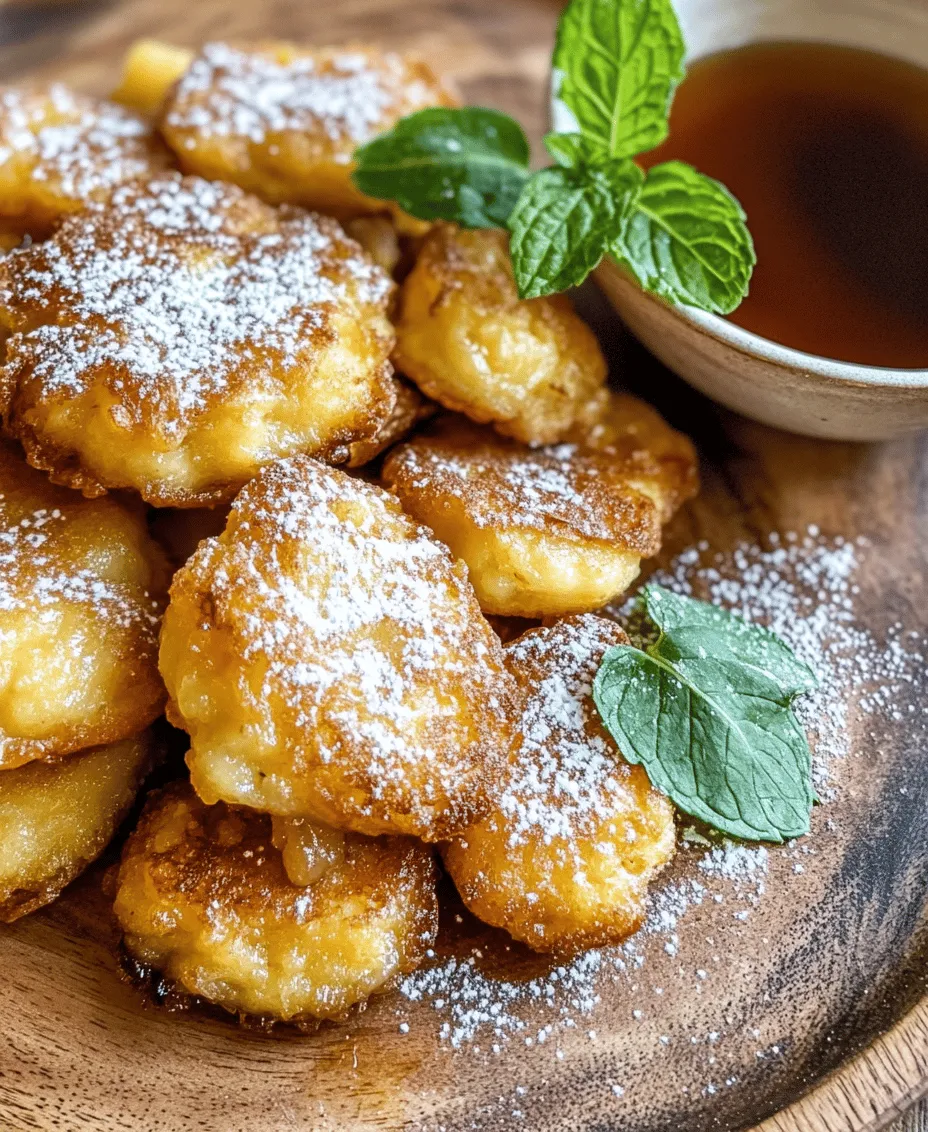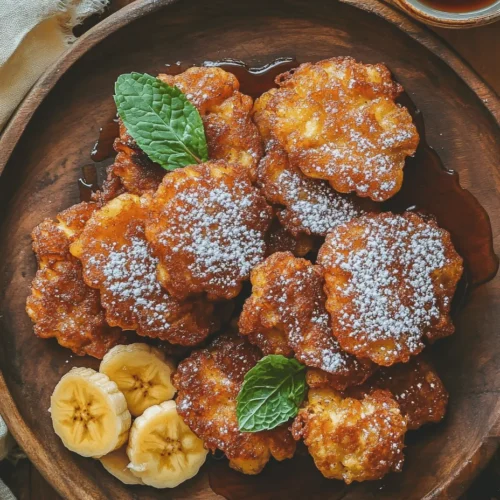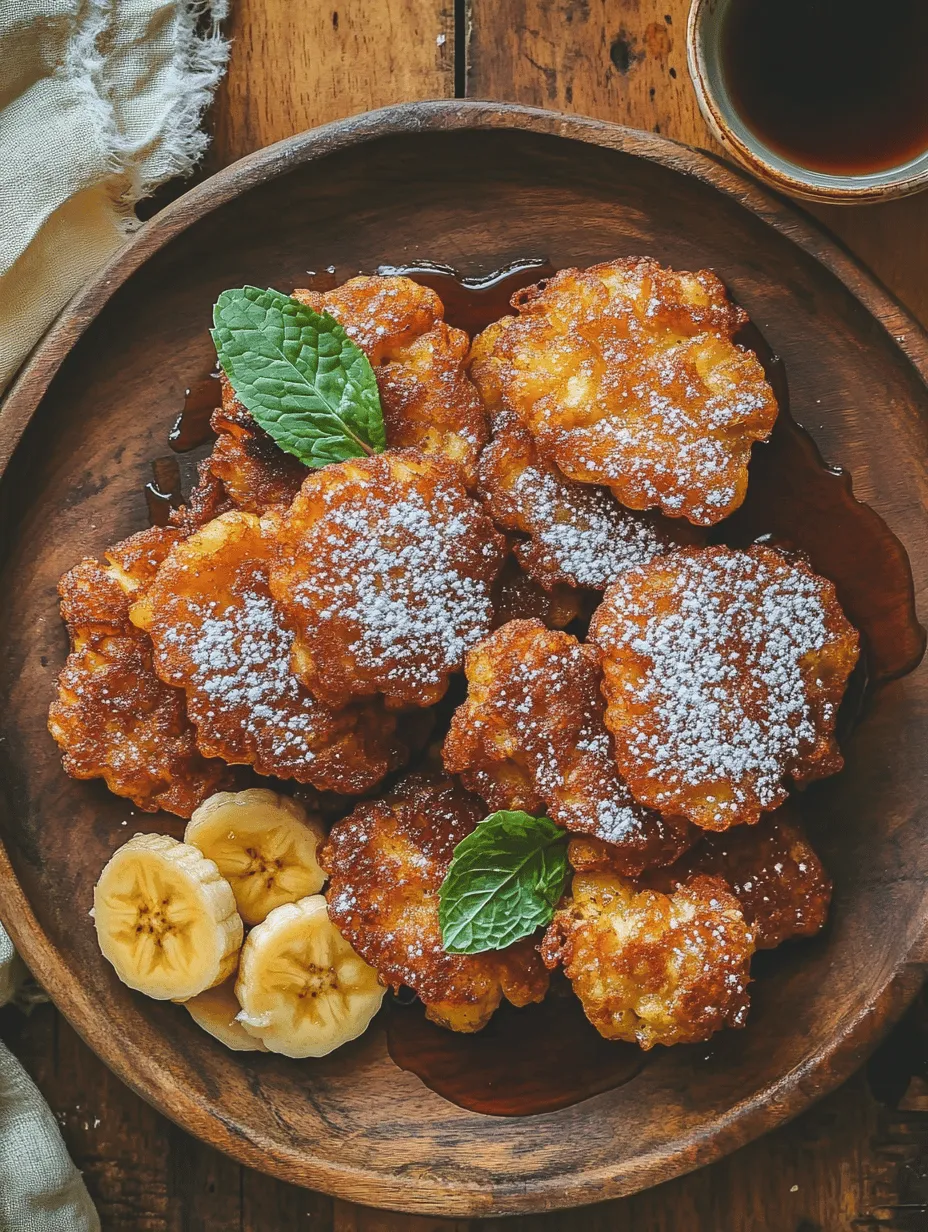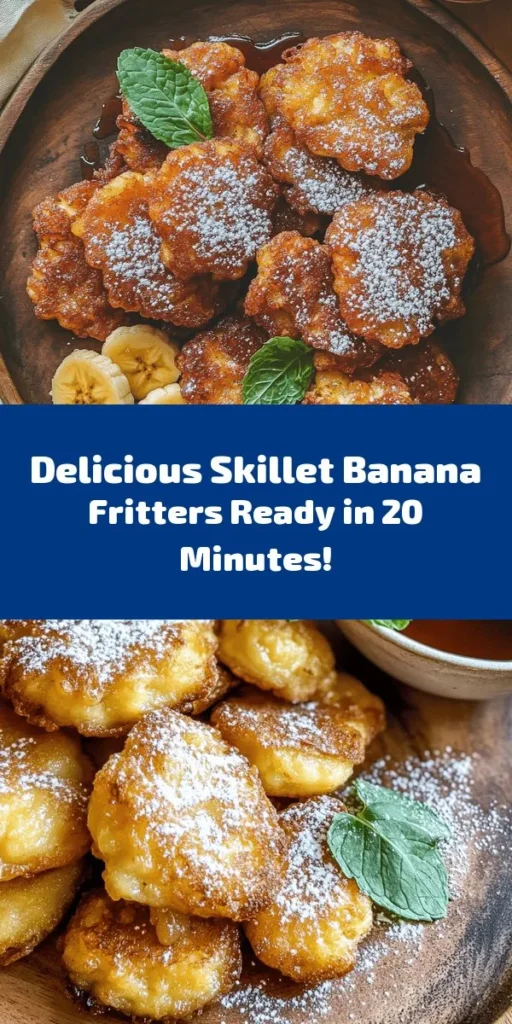Introduction
Imagine biting into a warm, golden fritter that’s crispy on the outside and delightfully soft on the inside, bursting with the sweet flavor of ripe bananas. Skillet banana fritters are more than just a treat; they are a celebration of flavors and textures that can elevate any meal, be it breakfast, a snack, or dessert. With their irresistible charm, these fritters have captured the hearts of food lovers around the world, making them a delightful addition to any occasion.
This article will guide you through the enticing world of skillet banana fritters, providing you with a detailed recipe that is not only easy to follow but also quick to prepare. Whether you are whipping up a batch for a weekend brunch, indulging in a sweet snack after school, or impressing guests at a gathering, these fritters are versatile enough to suit all your culinary needs.
Understanding the Appeal of Skillet Banana Fritters
Exploring the Origins and Cultural Significance of Banana Fritters
Banana fritters have a rich history and are enjoyed in various forms across different cultures. The concept of frying fruits in batter is not unique to one cuisine; it spans continents, with each region putting its own spin on the dish. For example, in Southeast Asia, banana fritters are often served as street food, enjoyed warm and crispy, often paired with a sweet dipping sauce. In the Caribbean, they may be found as a popular breakfast item, combining local ingredients to create a unique flavor profile.
This global perspective on banana fritters highlights their versatility and the universal love for fried treats. The simple combination of bananas and batter transcends cultural boundaries, making them a delightful snack enjoyed by people of all ages.
Highlighting the Versatility of Banana Fritters
One of the most appealing aspects of skillet banana fritters is their versatility. These fritters can be customized to suit a variety of tastes and dietary preferences. You can make them sweet by adding spices like cinnamon or nutmeg, or you can create a savory version by incorporating herbs and spices. Additionally, they can be served plain, dusted with powdered sugar, or accompanied by dips such as honey, maple syrup, or chocolate sauce.
Banana fritters also cater to different dietary needs. The batter can be adjusted to be gluten-free by using alternative flours like almond or coconut flour, and dairy-free options can be easily achieved by substituting regular milk with almond or oat milk. This adaptability makes skillet banana fritters a go-to option for families and gatherings, ensuring that everyone can enjoy a delicious treat.
Discussing Why They’re a Popular Choice for Families and Gatherings
Skillet banana fritters are particularly popular for families and gatherings due to their ease of preparation and the joy they bring to any table. They require minimal ingredients and can be whipped up in less than 30 minutes, making them an ideal choice for busy mornings or impromptu get-togethers.
Moreover, these fritters are not only tasty but also a great way to use up overripe bananas, ensuring that nothing goes to waste. Kids and adults alike are drawn to their sweet aroma and delightful crunch, making them a surefire hit at any family gathering or party. The interactive nature of frying the fritters together can also turn cooking into a fun family activity, creating lasting memories in the kitchen.
Ingredient Breakdown
To create mouthwatering skillet banana fritters, you’ll need a few key ingredients that come together to form the perfect batter. Let’s take a closer look at each ingredient and its role in this delightful recipe.
Overview of the Key Ingredients Used in Skillet Banana Fritters
1. Ripe Bananas: The star of the dish, ripe bananas provide natural sweetness and moisture to the fritters. Using overripe bananas not only enhances the flavor but also makes the fritters extra soft and tender.
2. All-Purpose Flour: This ingredient serves as the base for the batter, giving structure to the fritters. All-purpose flour creates a light and crispy exterior when fried.
3. Baking Powder: A crucial leavening agent, baking powder helps the fritters rise and become fluffy. It ensures that the fritters are light and airy rather than dense.
4. Sugar: While the bananas provide sweetness, additional sugar enhances the flavor of the fritters and contributes to the caramelization during frying.
5. Milk: This ingredient adds moisture to the batter, helping to achieve the right consistency. You can use any type of milk, including dairy-free alternatives, to suit your dietary preferences.
6. Egg: The egg acts as a binding agent, helping to hold the fritters together. It also adds richness to the flavor.
7. Salt: A pinch of salt balances the sweetness of the bananas and enhances the overall flavor of the fritters.
Detailed Examination of Each Ingredient’s Role in the Recipe
– Ripe Bananas: As the primary flavor component, bananas give the fritters their distinctive taste. The riper the banana, the sweeter and more flavorful the fritters will be. As bananas ripen, their starches convert to sugars, which is why overripe bananas are preferable for this recipe.
– All-Purpose Flour: The flour works to create the batter’s structure. While all-purpose flour is commonly used, feel free to experiment with other flours based on dietary needs. For instance, whole wheat flour can add a nutty flavor and more fiber, while gluten-free flour blends can accommodate those with gluten sensitivities.
– Baking Powder: This leavening agent is essential for achieving the right texture. It creates tiny bubbles in the batter, resulting in light and fluffy fritters that are crispy on the outside.
– Sugar: In addition to sweetening the fritters, sugar plays a critical role in the frying process. It caramelizes and forms a beautiful golden crust, enhancing the fritters’ visual appeal and flavor.
– Milk: The type of milk you choose can influence the flavor and texture of the fritters. Whole milk will yield richer fritters, while almond or oat milk can add unique flavors while keeping the dish dairy-free.
– Egg: Eggs contribute to the fritters’ richness and help bind the ingredients together. If you prefer an egg-free option, you can substitute with a flaxseed egg or unsweetened applesauce.
– Salt: A small amount of salt is crucial for balancing flavors. It enhances the sweetness of the bananas and ensures the fritters are well-seasoned.
Highlighting Potential Substitutes for Dietary Restrictions
Whether you’re navigating food allergies or dietary preferences, skillet banana fritters can easily be adapted. Here are some common substitutes:
– Gluten-Free Flour: If you require a gluten-free option, you can substitute all-purpose flour with a gluten-free flour blend. Almond flour and coconut flour are also great alternatives but may require adjustments to the liquid content.
– Dairy Alternatives: For those avoiding dairy, almond milk, coconut milk, or soy milk can replace regular milk without sacrificing flavor.
– Egg Substitutes: If you’re vegan or egg intolerant, consider using a flax egg (1 tablespoon ground flaxseed mixed with 3 tablespoons water, let sit for 5 minutes) or 1/4 cup of unsweetened applesauce for each egg.
With a clear understanding of the ingredients and their roles, you are well-equipped to create the perfect skillet banana fritters tailored to your taste and dietary needs.
Step-by-Step Instructions for Perfect Skillet Banana Fritters
Now that you have all your ingredients ready, it’s time to dive into the preparation process. Follow these detailed steps to whip up your own batch of skillet banana fritters.
Preparation and Assembly of Ingredients
1. Gather Your Ingredients: Before you begin, ensure you have all your ingredients measured out and ready to go. This will streamline the cooking process and make it easier to focus on creating delicious fritters.
2. Mash the Bananas: In a large mixing bowl, peel the ripe bananas and use a fork to mash them until smooth. You can leave some small chunks if you prefer a bit of texture in your fritters.
3. Mix the Dry Ingredients: In a separate bowl, combine the all-purpose flour, baking powder, sugar, and salt. Whisk together until well blended. This step ensures that the leavening agent is evenly distributed throughout the flour.
4. Combine Wet Ingredients: In another bowl, whisk together the milk and egg until fully incorporated. If you’re using a dairy-free milk or an egg substitute, mix it accordingly to achieve a smooth consistency.
5. Combine Wet and Dry Mixtures: Pour the wet mixture into the bowl with the mashed bananas. Gradually add the dry ingredients to the wet ingredients, stirring gently until just combined. Be careful not to overmix; a few lumps are perfectly fine. Overmixing can lead to dense fritters.
Detailed Instructions for Mixing the Batter
1. Fold in the Ingredients: Gently fold the dry mixture into the wet mixture using a spatula or wooden spoon. This method helps maintain the lightness of the batter while ensuring everything is evenly incorporated.
2. Check the Consistency: The batter should be thick but pourable. If it’s too dry, you can add a splash more milk to achieve the desired consistency. If it’s too runny, sprinkle a little more flour until it thickens up.
3. Heat the Skillet: Place a non-stick skillet or frying pan over medium heat and add a generous amount of oil for frying. You want enough oil to coat the bottom of the skillet to achieve that glorious golden-brown color.
4. Test the Oil Temperature: To ensure the oil is hot enough, drop a small spoonful of batter into the oil. If it sizzles and rises to the surface, the oil is ready for frying. If it sinks flat, the oil needs more time to heat up.
Tips for Achieving the Ideal Frying Temperature
1. Temperature Control: Maintaining the right frying temperature is crucial for achieving the perfect fritters. If the oil is too hot, the outside will burn before the inside cooks through. Conversely, if it’s too cool, the fritters will absorb excess oil and become greasy.
2. Batch Frying: Fry the fritters in small batches to avoid overcrowding the skillet. This ensures that the temperature remains consistent and allows for even cooking.
3. Timing: Typically, each fritter will take about 2 to 3 minutes per side to cook. Keep an eye on them and flip them once they are golden brown.
4. Draining Excess Oil: Once your fritters are fried to perfection, transfer them to a plate lined with paper towels to absorb any excess oil. This step will help keep them crispy.
By following these detailed instructions, you are on your way to creating delicious skillet banana fritters that will delight your family and friends. Keep an eye out for the next part of this article, where we will delve deeper into some expert tips for achieving the best results and answer common questions about this delectable treat.

Guidance on Flipping and Cooking to Perfection
To achieve perfectly golden and fluffy skillet banana fritters, the cooking method is crucial. After placing the fritters in your preheated skillet, allow them to cook undisturbed for about 2 to 3 minutes. This initial cooking time allows the fritters to form a golden crust on the bottom, which is key to holding their shape when flipped.
When it’s time to flip, gently slide a spatula underneath each fritter, ensuring you support the entire surface. Lift it carefully and turn it over in one smooth motion. If they stick slightly, let them cook for another 30 seconds before attempting again. It’s important not to overcrowd the skillet; cook in batches if necessary to ensure even heat distribution and prevent steaming.
Once flipped, allow the fritters to cook for an additional 2 to 3 minutes on the other side. You’re aiming for a deep golden brown on both sides for optimal flavor and texture. For best results, monitor the heat; if they are browning too quickly, lower the heat slightly.
After removing the fritters from the skillet, place them on a plate lined with paper towels to absorb any excess oil. This step not only helps in keeping the fritters crispy but also enhances their flavor by removing any greasiness.
Serving Suggestions and Pairings
Skillet banana fritters are incredibly versatile and can be served in a variety of creative ways. Here are some delightful suggestions to elevate your fritter experience:
1. Sweet Toppings: A classic way to enjoy banana fritters is by dusting them with powdered sugar for a delicate sweetness. Alternatively, drizzle with warm maple syrup or honey for a more indulgent option. Both add a wonderful contrast to the fritters’ warm, fluffy texture.
2. Fresh Fruits: Enhance the freshness of your dish by serving the fritters with slices of fresh fruit, such as strawberries, blueberries, or even more bananas. This not only adds a pop of color to your plate but also complements the fritters’ flavor beautifully.
3. Whipped Cream or Yogurt: For an extra layer of creaminess, serve the fritters with a dollop of whipped cream or a scoop of yogurt. Greek yogurt can be a healthier option, providing a tangy contrast that balances the sweetness of the fritters.
4. Nut Butter: Spread a layer of almond butter or peanut butter on top of the fritters for a deliciously nutty twist. This adds protein and healthy fats, making your meal more filling.
5. Beverage Pairings: When it comes to drinks, consider serving your fritters with a cup of coffee, tea, or a refreshing smoothie. A banana smoothie, made with yogurt and a hint of cinnamon, can be a fantastic complement, tying the flavors together nicely.
Nutritional Information
Understanding the nutritional profile of skillet banana fritters can help you appreciate their benefits. Each serving (approximately 2 fritters) contains roughly:
– Calories: 180-220 (depending on the cooking oil used)
– Protein: 2-4g
– Carbohydrates: 30-35g
– Dietary Fiber: 2-3g
– Sugars: 7-10g
– Fats: 6-10g
Bananas are a rich source of potassium, vitamin C, and vitamin B6, contributing to heart health and muscle function. They also provide a natural sweetness, reducing the need for additional sugar in your fritter batter.
To make these fritters even healthier, consider the following tips:
– Use Whole Wheat Flour: Substitute all-purpose flour with whole wheat flour to increase fiber content.
– Reduce Sugar: If you prefer a less sweet fritter, reduce the amount of sugar in the batter. The natural sweetness of ripe bananas can often suffice.
– Opt for Air Frying: If you’re looking to cut down on oil, consider using an air fryer for a healthier take on this recipe, allowing for deliciously crispy fritters with less fat.
Storage and Reheating Tips
If you find yourself with leftover banana fritters (a rare occurrence, but it can happen!), storing them properly is essential to maintain their texture and flavor. Here’s how to do it:
1. Storage: Allow the fritters to cool completely before storing them in an airtight container. To prevent them from becoming soggy, place a paper towel at the bottom of the container to absorb any moisture. Store them in the refrigerator for up to 3 days.
2. Reheating: When you’re ready to enjoy the leftovers, the oven is your best friend. Preheat your oven to 350°F (175°C) and place the fritters on a baking sheet lined with parchment paper. Heat for about 10 minutes or until warmed through. This method helps to restore their crispiness.
3. Creative Leftover Ideas: If you have more fritters than you can eat, consider transforming them into a new dish. Crumble the fritters over a bowl of yogurt or oatmeal for a delicious breakfast. Alternatively, blend them into a smoothie for a quick snack, combining with milk or a dairy-free alternative for a delightful treat.
Conclusion
Skillet banana fritters are more than just a simple recipe; they embody comfort, creativity, and culinary delight. With their ease of preparation and delicious taste, these fritters can quickly become a family favorite. Whether enjoyed fresh off the skillet, adorned with sweet toppings, or as part of a larger spread, skillet banana fritters offer a satisfying and flexible dish that can be enjoyed by all.
Experiment with various toppings and sides to create a personalized experience every time you make these fritters. Their versatility makes them perfect for breakfast, brunch, or even dessert. Moreover, with thoughtful storage and reheating methods, you can savor their delightful taste long after the cooking is done. So gather your ingredients, fire up that skillet, and embark on a delicious journey of flavor that brings the joy of banana fritters to your kitchen!



